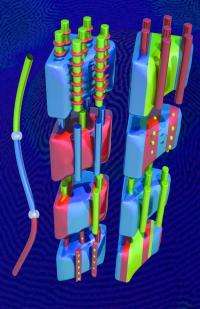Emerging theoretical framework may guide researchers through the complex world of multiblock polymers

(Phys.org) -- Thanks to advances in polymer chemistry and a wide variety of monomer constituents to choose from, the world of multiblock polymers is wide open. These polymers can result in an astonishing array of materials, customizable to almost any specification. However, the flood of options could be overwhelming, without a theoretical framework to guide research. UC Santa Barbara scientists Glenn Fredrickson and Kris Delaney address that issue in their paper, "Multiblock Polymers: Panacea or Pandora's Box?" The paper appears in the latest edition of the journal Science.
Polymers are large molecules comprised of repeating sequences of monomers. When more than one monomer type is present and the dissimilar monomers are organized and chemically bound into "blocks," the resulting multiblock polymers can serve as the basis for a multitude of materials, to be used in applications as diverse as tennis shoes and solar cells. Since the genesis of polymer science in the 1950's, when scientists had only limited numbers of monomers, and, methods to choose from in creating multiblock polymers, the field has expanded. Scientists may now create materials using monomers from a variety of sources, from petroleum to renewable feedstocks such as sugar or cellulose.
"The Pandora's box is that you have so many monomers that you can put together and in so many block sequences," said Fredrickson, a professor of chemical engineering, explaining that the properties will vary according to sequence and by virtue of the interactions among the blocks. Because multiblock copolymers can "self-assemble" into nanometer-sized domains, these materials can exhibit remarkable combinations of properties, such as soft, strong, and elastic –– as in tennis shoe soles or skateboard wheels. For higher-tech applications, the researchers are currently partnering with the company Intel to develop multiblock polymers that will enable patterning of microelectronic devices at finer scales and lower cost.
The problem, say Fredrickson and Delaney, a project scientist in the Department of Engineering, has become the sheer number of possible combinations for these monomers. There are now so many, that choosing what multiblock polymer to make –– and what monomers to make it from –– has become an issue.
"It is a counting problem," said Fredrickson, referring to the potential for millions of different polymers that could be created with today's chemistry, a number that increases by leaps and bounds for every new block and monomer species added to the selection.
The researchers, who also include scientists from the University of Minnesota and the University of Texas, suggest an approach that addresses materials performance needs by combining predictive computer simulation methods with advanced synthetic and structural characterization tools.
"Our simulation methods for predicting the self-assembled structures of multiblock polymers are quite advanced, and we are getting better at relating those nano-structures to the properties of the material," said Fredrickson. "Multiblock polymers are extremely versatile –– there is enormous latitude of design freedom, and it's very promising in terms of developing materials with truly unique properties."
Provided by University of California - Santa Barbara




















